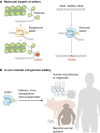The NIH Somatic Cell Genome Editing program
- PMID: 33828315
- PMCID: PMC8026397
- DOI: 10.1038/s41586-021-03191-1
The NIH Somatic Cell Genome Editing program
Abstract
The move from reading to writing the human genome offers new opportunities to improve human health. The United States National Institutes of Health (NIH) Somatic Cell Genome Editing (SCGE) Consortium aims to accelerate the development of safer and more-effective methods to edit the genomes of disease-relevant somatic cells in patients, even in tissues that are difficult to reach. Here we discuss the consortium's plans to develop and benchmark approaches to induce and measure genome modifications, and to define downstream functional consequences of genome editing within human cells. Central to this effort is a rigorous and innovative approach that requires validation of the technology through third-party testing in small and large animals. New genome editors, delivery technologies and methods for tracking edited cells in vivo, as well as newly developed animal models and human biological systems, will be assembled-along with validated datasets-into an SCGE Toolkit, which will be disseminated widely to the biomedical research community. We visualize this toolkit-and the knowledge generated by its applications-as a means to accelerate the clinical development of new therapies for a wide range of conditions.
Conflict of interest statement
K.S. receives sponsored research support from Spotlight Therapeutics. E.J.S. is a co-founder and advisor of Intellia Therapeutics. C.A.G. is a co-founder of Tune Therapeutics, Element Genomics and Locus Biosciences, and an advisor to Sarepta Therapeutics, Levo Therapeutics and Iveric Bio. D.R.L. is a co-founder or founder and scientific advisor of Editas Medicine, Pairwise Plants, Beam Therapeutics and Prime Medicine. S.Q.T. is a member of the scientific advisory board of Kromatid, Inc. D.G.A. is a co-founder of CRISPR Therapeutics, Sigilon, Verseau, VasoRx and Orna, and a consultant for Translate Bio and Obsidian Therapeutics. A.A. is a co-founder of StrideBio and TorqueBio, and an advisor to AstraZeneca, Sarepta Therapeutics, Gemini Therapeutics and BridgeBio. J.F.B. is a co-founder of Metagenomi. J.W.M.B. receives research support from NovaDip Biosciences, Philips Healthcare and Weinberg Medical Physics. D.F.C. and J.C. are employees and shareholders in Recombinetics, Inc. J.E.D. is a co-founder of Guide Therapeutics. K.J.C. is a co-founder of Recombinetics, Inc. and LifEngine Technologies. B.E.D. is on the scientific advisory board of Tevard Biosciences. J.A.D. is a co-founder of Caribou Biosciences, Editas Medicine, Scribe Therapeutics, Intellia Therapeutics and Mammoth Biosciences; a scientific advisory board member of Caribou Biosciences, Intellia Therapeutics, eFFECTOR Therapeutics, Scribe Therapeutics, Mammoth Biosciences, Synthego, Algen Biotechnologies, Felix Biosciences and Inari; a Director at Johnson & Johnson; and has research projects sponsored by Biogen, Pfizer, AppleTree Partners and Roche. S.C.E. is co-founder and chief executive officer of LifEngine Technologies, co-founder of LEAH Labs and chief scientific officer of Mettaforge Therapeutics. D.M.G. is a co-founder and chief scientific advisor for Opsis Therapeutics and holds equity in this company, and also receives sponsored research support from Ascidian Therapeutics. G.G. is a scientific co-founder of Voyager Therapeutics, Adrenas Therapeutics and Aspa Therapeutics. P.M.G. is a co-founder of Cybrexa Therapeutics and Delmab Bio and an advisor to pHLIP, Inc. P.B.M. is on the scientific advisory board and receives support for sponsored research from Spirovant Sciences, Inc. S.K. is the chief scientific officer and co-founder of SafeGen Therapeutics. W.M.S. is a co-founder of and receives research support from Stradefy Biosciences. J.K.W. is a consultant for Flagship Pioneering.
Figures


References
-
- High KA, Roncarolo MG. Gene therapy. N. Engl. J. Med. 2019;381:455–464. - PubMed
-
- Anzalone AV, Koblan LW, Liu DR. Genome editing with CRISPR–Cas nucleases, base editors, transposases and prime editors. Nat. Biotechnol. 2020;38:824–844. - PubMed
-
- Urnov FD, et al. Highly efficient endogenous human gene correction using designed zinc-finger nucleases. Nature. 2005;435:646–651. - PubMed
Publication types
MeSH terms
Grants and funding
- U01 AI145965/AI/NIAID NIH HHS/United States
- R01 NS111990/NS/NINDS NIH HHS/United States
- U01 EB028892/EB/NIBIB NIH HHS/United States
- U01 ES032673/ES/NIEHS NIH HHS/United States
- R01 NS076991/NS/NINDS NIH HHS/United States
- UG3 AI150550/AI/NIAID NIH HHS/United States
- R35 GM119644/GM/NIGMS NIH HHS/United States
- P51 OD011106/OD/NIH HHS/United States
- DP2 DK133821/DK/NIDDK NIH HHS/United States
- U01 DK127587/DK/NIDDK NIH HHS/United States
- U01 DK127553/DK/NIDDK NIH HHS/United States
- UH3 TR002668/TR/NCATS NIH HHS/United States
- UG3 AI150551/AI/NIAID NIH HHS/United States
- U42 OD027090/OD/NIH HHS/United States
- UH3 NS111688/NS/NINDS NIH HHS/United States
- UH3 HL147352/HL/NHLBI NIH HHS/United States
- U01 EB029371/EB/NIBIB NIH HHS/United States
- UH3 EB028907/EB/NIBIB NIH HHS/United States
- U01 EY032333/EY/NEI NIH HHS/United States
- U01 EB028899/EB/NIBIB NIH HHS/United States
- P30 ES005605/ES/NIEHS NIH HHS/United States
- P01 HL152960/HL/NHLBI NIH HHS/United States
- UG3 HL151545/HL/NHLBI NIH HHS/United States
- UH2 EB028910/EB/NIBIB NIH HHS/United States
- P51 OD011107/OD/NIH HHS/United States
- UG3 NS111688/NS/NINDS NIH HHS/United States
- S10 OD020012/OD/NIH HHS/United States
- UG3 HL147352/HL/NHLBI NIH HHS/United States
- UC2 DK126023/DK/NIDDK NIH HHS/United States
- U42 OD026635/OD/NIH HHS/United States
- U42 OD026645/OD/NIH HHS/United States
- UG3 TR002668/TR/NCATS NIH HHS/United States
- R56 DK122380/DK/NIDDK NIH HHS/United States
- UH2 EB028907/EB/NIBIB NIH HHS/United States
- UH3 HL147366/HL/NHLBI NIH HHS/United States
- U01 HL145792/HL/NHLBI NIH HHS/United States
- S10 OD028713/OD/NIH HHS/United States
- U24 HG010423/HG/NHGRI NIH HHS/United States
- U42 OD027094/OD/NIH HHS/United States
- UH3 EB028910/EB/NIBIB NIH HHS/United States
LinkOut - more resources
Full Text Sources
Other Literature Sources

